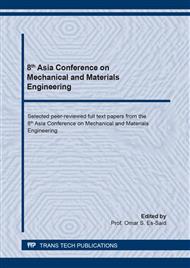[1]
Polymeric Membranes,, Solecta Membranes, [Online]. Available: https://www.solectamembranes.com/polymeric-membranes. [Accessed 7 May 2020].
Google Scholar
[2]
A. C. Lopes, C. C. Ferreira, C. M. Costa and S. Mendez, Crystallization kinetics of montmorillonite/poly(vinylidene fluoride) composites and its correlation with the crystalline polymer phase formation,, Thermochimica Acta, vol. 574 , pp.19-25, (2013).
DOI: 10.1016/j.tca.2013.08.003
Google Scholar
[3]
P. Luis, Polymeric Membranes,, in Fundamental Modelling of Membrane Systems, Elsevier, 2018, pp.1-23.
Google Scholar
[4]
R. R. Aquino, M. S. Tolentino, J. V. Angeles and H. AzelleMillanod, Fabrication and Characterization of Electrospun Polysulfone (PSF)/Organo-Montmorillonite (O-MMT) Nanostructured Membranes,, Materials Science Forum, vol. 916, pp.125-129, (2018).
DOI: 10.4028/www.scientific.net/msf.916.125
Google Scholar
[5]
Y. Ma, W. Tong, Q. Wang, Q. An and Y. Zhang, Montmorillonite/PVDF-HFP-based energy conversion and storage films with enhanced piezoelectric and dielectric properties,, Composites Science and Technology, vol. 168, pp.397-403, 2018.
DOI: 10.1016/j.compscitech.2018.10.009
Google Scholar
[6]
H. Li and H. Kim, Thermal degradation and kinetic analysis of PVDF/modified MMT nanocomposite membranes,, Desalination, vol. 234 , pp.9-15, (2008).
DOI: 10.1016/j.desal.2007.09.064
Google Scholar
[7]
G. Kang and Y. Cao, Application and modification of poly(vinylidene fluoride) (PVDF) membranes - A review,, Journal of Membrane Science, vol. 463, pp.145-165, (2014).
DOI: 10.1016/j.memsci.2014.03.055
Google Scholar
[8]
S. Park, Y. Ahn, H. Kim, K. Y. Cho, S. S. Hwang, J. Lee and K. Baek, Effects of methacrylate based amphiphilic block copolymer additives on ultra filtration PVDF membrane formation.,, Separation and Purification Technology,, vol. 202, pp.34-44, (2018).
DOI: 10.1016/j.seppur.2018.03.018
Google Scholar
[9]
A. D. de Oliveira and C. A. G. Beatrice, Polymer Nanocomposites with Different Types of Nanofiller,, in Nanocomposites – Recent Evolutions, IntechOpen, (2018).
DOI: 10.5772/intechopen.81329
Google Scholar
[10]
F. Uddin, Montmorillonite: An Introduction to Properties and Utilization,, in Current Topics in the Utilization of Clay in Industrial and Medical Applications, IntechOpen, (2018).
DOI: 10.5772/intechopen.77987
Google Scholar
[11]
H. Rajabi, N. Ghaemi, S. S. Madaeni, P. Daraei, M. AliKhadivi and M. Falsafi, Nanoclay embedded mixed matrix PVDF nanocomposite membrane: Preparation, characterization and biofouling resistance,, Applied Surface Science, vol. 313, pp.207-214, (2014).
DOI: 10.1016/j.apsusc.2014.05.185
Google Scholar
[12]
C. Y. Lai, A. Groth, S. Gray and M. Duke, Preparation and characterization of poly(vinylidene fluoride)/nanoclay 2 nanocomposite flat sheet membranes for abrasion resistance.,, Water research, vol. 57, pp.56-66, (2014).
DOI: 10.1016/j.watres.2014.03.005
Google Scholar
[13]
H. Bai, X. Wang, Y. Zhou and L. Zhang, Preparation and characterization of poly(vinylidene fluoride) composite membranes blended with nano-crystalline cellulose,, Progress in Natural Science: Materials International, vol. 3, no. 22, pp.250-257, (2012).
DOI: 10.1016/j.pnsc.2012.04.011
Google Scholar
[14]
S. U. Adikary and D. D. Wanasinghe, Characterization of locally available Montmorillonite clay using FTIR technique,, Annual Transactions of Institute of Engineers Sri Lanka, vol. 1, (2012).
Google Scholar
[15]
E. W. Maina, H. J. Wanyika and A. N. Gacanja, Instrumental Characterization of Montmorillonite Clay by FT-IR and XRD from J.K.U.A.T Farm, in the Republic of Kenya.,, Chemistry and Materials Research, vol. 7, no. 10, (2015).
Google Scholar


